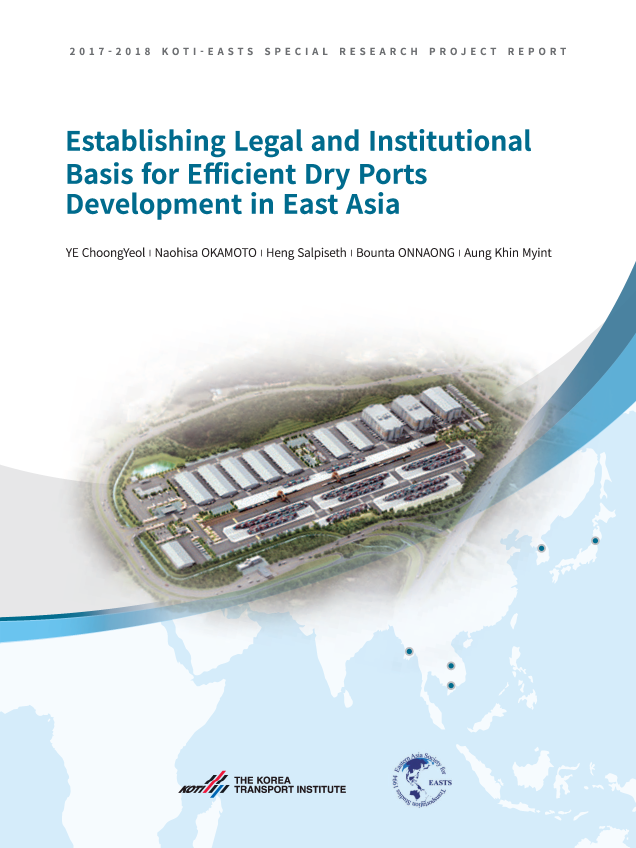Basic Report

RESEARCH
KOTI - Korea Transport institute- Date
April 30 2018
- Page(s)
174 page(s)

Challenges regarding capacity expansion, environment issues, and community conflicts are raising challenges to global container trade and container ports. Global supply chains have been integrated with freight transport and logistics facilities. The development for hinterland of seaports is considered to mitigate or resolve the challenges for container trade and container shipping. The increased scale of container ships trigger a pressure on seaports which have limited volume capacity for container handling. It becomes critical to setting up enough capability for distributing containers or equivalents to and from hinterland for the smooth operation of seaports and the integrated supply chains.
The levels of service in supply chains are one of the critical elements that decide the efficiency of the whole supply chain. In this sense, many countries attempt to expand seaport capabilities to support their supply chains in international trade, and the concept of the dry port has attracted attention from countries in need of improved supply chains. A dry port is broadly defined as an inland logistics terminal that is directly connected by rail and/or road to a seaport where shippers can leave and/or collect standardized units directly at the seaport. It offers services that are normally available at a seaport, such as customs clearance, storage, forwarding, and other value-added logistics services.
Preface 5
Contents 6
Table 8
Figure 9
Chapter 1 Introduction and Overview 12
Chapter 2 Status and Plans of Dry Port Development in Cambodia 26
2.1 General Information 28
2.2 Logistics Infrastructure and Key Issues in the Logistics Sector 32
2.3 Government Institutions for Logistics Sector 39
2.4 Institutional and Legal Framework 41
2.5 Existing Institutional and Legal Framework for Dry Port Development 42
2.6 National Plan for Development of a Logistics Hub for Multi-Modal Transport 44
2.7 National Strategies and Plans for the Development of Economic Corridors and International Gateways 48
2.8 Financing the Development of Logistics Infrastructures 49
2.9 Laws and Regulation for the Development of Logistics Infrastructures 51
2.10 Diagnosis on Current System for Developing Logistics Infrastructures 51
2.11 Conclusion and Suggestions 54
Chapter 3 Status and Importance of Dry Port Development in Land-Locked Lao PDR 57
3.1 General Information 59
3.2 Logistics Status in Laos PDR 61
3.3 Government Organization 64
3.4 Institutional and Legal Framework 66
3.5 Development Plan for Dry Ports 68
3.6 Strategies and Plans Regarding the ASEAN Highways and Trans Asia Railway 71
3.7 The Development Process of Logistics Infrastructures: Administration and Financing 73
3.8 Case Study: Savan Logistics Dry port 73
3.9 Laws and Regulations for the Development of Logistics Infrastructure 74
3.10 Diagnosis of the Current System for Developing Logistics Infrastructure 78
3.11 Legal Loopholes or Subjects of Improvement in Developing Logistics Infrastructures 81
3.12 Conclusions and Suggestions 82
Chapter 4 Issues and Challenges of Dry Port Development in Myanmar 85
4.1 General Information 87
4.2 Issues in the Field of Logistics 87
4.3 Government Organizations 92
4.4 Institutional and Legal Framework 93
4.5 Diagnosis on the Current System for Developing Logistics Infrastructures 97
4.6 Conclusion and Suggestions 99
Chapter 5 Logistics Issues and Regional Dry Port Development in Japan 103
5.1 General Information 105
5.2 Issues of Logistics in Japan 105
5.3 Japanese Government Organizations related to Logistics 108
5.4 Legislation and Policy 111
5.5 Case Studies 117
5.6 Challenges and Conclusions 122
Chapter 6 Legal and Institutional Framework of Dry Port Development in Korea 125
6.1 Introduction 127
6.2 Dry Port Development in Korea 129
6.3 The Process of Dry Port Development 133
6.4 Case Study: Uiwang ICD 134
6.5 Legal and Institutional System for Developing a Dry Port in Korea 138
6.6 Conclusion and Suggestions 150
Chapter 7 Conclusion and Suggestions 153
Reference 160